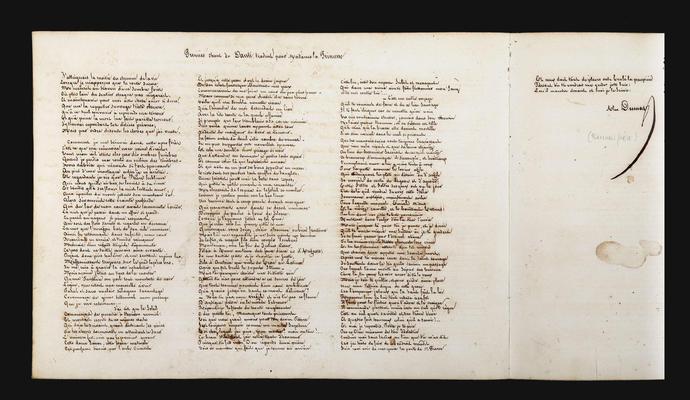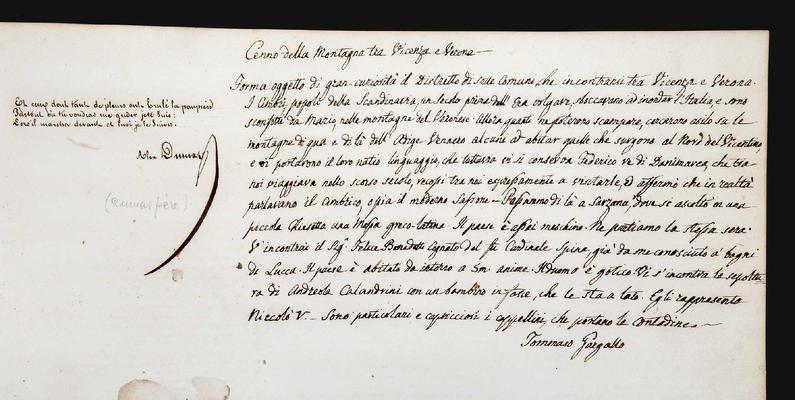Alexandre Dumas, père, Tommaso Gargallo
Premier chant du Dante traduit pour Madame la Princesse.
[Possibly datable to November 1835].AND Tommaso Gargallo, Cenno della montagna tra Vicenza e Verona. [After 1825].
210x290 mm. One bifolium, fols. [1]r and [2]v blanks. I. Dumas's text written in dark ink in three columns, 48 lines, on fol. [1]v; on the lefthand side of fol. [2]r the last three lines of the text in one column, signed below ‘Alex Dumas'. II. Gargallo's text written in dark ink in one column on fol. [2]r, 14 lines, with his signature below. A small tear at the lower blank margin of the second leaf. On fol. [2]r the twentieth-century pencilled note ‘Dumas père'.
Provenance: Livio Ambrogio collection.
Alexandre Dumas père's translation into French of the first canto of the Inferno, written and signed by the writer himself, a precious autograph possibly datable to November 1835. The text appeared in print only in March 1836 in the Revue des Deux Mondes, as an appendix to the essay Guelfes et Gibelins also by Dumas.
Between May and November 1835 Dumas had travelled in Sicily; he stayed in Syracuse from 4 to 6 November. As he relates in his account of his travels on the island, while in Syracuse he met the erudite count Tommaso Gargallo Marquis of Castel Lentini,a correspondent of Vittorio Alfieri and Giacomo Leopardi, and whose renowned translation of Horace Dumas considered to be the finest into Italian. The French writer also got to know Gargallo's son Francesco, who was his guide in Syracuse. In the first part of his trilogy Impressions de voyage dans le Royaume de Naples (1842), Dumas recalls these encounters, and in particular the figure of Francesco Gargallo, whom he describes as a character “spirituel comme un Français moderne et hospitalier comme un vieux Syracusain”.
On this manuscript leaf Dumas copied out in his own hand his translation of the first canto of the Inferno, alongside a short prose passage written and signed by Tommaso Gargallo, describing the mountainous region between Verona and Vicenza, which the Sicilian count had visited in 1825, probably as a guest of his friend the writer Ippolito Pindemonte (1753-1828). The provenance of this leaf remains a mystery, but it is possible that it was at some point extracted from a kind of Liber amicorum belonging to Gargallo,who often quotes Dante and the Commedia in his writings, and in 1832 lectured on Cantoxxxiiiof the Inferno. The dedicatee of Dumas's translation – ‘Madame la Princesse' – was possibly the wife of Tommaso Gargallo, Lucia Grimaldi.



